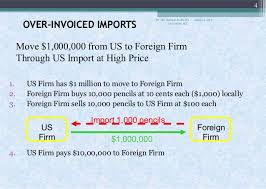If you are a compliance officer at an international bank, you are acquainted with the tactics of trade-based money laundering (TBML). For those who are not familiar with the term, it is one of the methods money launderers employ to move criminal profits across international borders, using false invoicing of import and export transactions. It is believed to constitute 50-80% of all international money laundering transactions, and it is often not understood by many financial professionals.
More specifically:
(1) Funds are moved out of a country by the under-invoicing of exports or the over-invoicing of imports.
(2) Funds are moved into a country by the over-invoicing of exports or the under-invoicing of imports.

Compliance officers seeking to accurately determine whether the sales price of specific goods being exported or imported are at or near the market price often use the web-based International Price Profiling System (IPPS), offered by Professor John Zdanowicz' International Trade Alert which uses the Department of Commerce statistics of all international trade transactions. The program tells you whether your client's transaction falls within five per cent (5%) of the current market value of those goods. The company has Country, Product and Customs District Risk Profiles available to supplement your searches, during an investigation, if you are looking to spot a trend.

In the event that your inquiry discloses pricing inconsistent with the current market value of the goods being traded, it is submitted that you employ social media and social networking resources, to expand your information on the individuals who you believe may be engaging in TBML through your bank. In TBML we often focus solely on the goods, and the money, while close scrutiny of the participants may expose links and connections to still other possible TBML transactions, both current as well as historical.
Now, let's move on to the value-added portion of the investigation:
(1) You will want to take the photo identification you have on file, on the individuals involved in the corporation that is engaged in the suspicious ( i.e. possible TBML) transactions, and, using your facial recognition software system, search for those individuals in social media, social networking sites, and other image resources. Don't worry if your primary target is not on Facebook; the system will show you his image where it appears on sites of friends, associates, family members, clubs, and other social contacts he may have.
(2) The idea is to identify their possible criminal associates and co-conspirators, partners, vendors and anyone else who is assisting your clients in this criminal operation.
(3) Are any of the names you found convicted felons with prior Federal prison time? One can engage in the import-export industry with a record. You might want to run the individuals you found through the Federal database known as PACER, for Public Access to Court Electronic records. https://www.pacer.gov/

(4) Are your clients' members of an organized crime syndicate? Your social media search will quickly identify their social structure. if you are unsure, run the facial recognition software program on the most prominent face you find.

When you have a potential trade-based money laundering transaction, digging into the backgrounds of the players will often yield critical information on other transactions, in the past, that you may have missed. Always follow up TBML hits on IPPS with social media searches on the individuals around the transaction, both direct, and remote.
Chronicles of Monte Friesner - Financial Crime Analyst 
Contributed by Kenneth Rijock - Financial Crime Consultant









